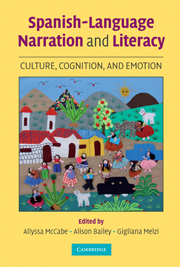PART THREE - NARRATIVE LINKS TO LITERACY AND OTHER SCHOOL ACHIEVEMENTS
Published online by Cambridge University Press: 05 June 2012
Summary
The third and final part of this book focuses on the link between oral narration and literacy acquisition for Spanish-speaking children in the United States. Much has been made of this link within the predominantly monolingual English-speaking population and, to some degree, the extent to which it is replicated in other populations of students, such as atypically developing children, African American students, and low-income students. Less is known about how the narrative discourse knowledge of Spanish-English bilingual students plays a role in their later literacy development and overall school achievement, yet it is critical that we know more about this heterogeneous population of students. Children who come to school speaking a language other than English (most often Spanish) are the fastest growing segment of the public school population, and these students are among the most vulnerable to school failure (Batalova, Fix, & Murray, 2007).
Two of the three chapters in this part, the first by Sparks and the second by Bailey, Moughamian, and Dingle, empirically explore the links between oral narrative and formal schooling experiences and outcomes. Chapter 11 focuses on the very first encounters of U.S. schooling by young Latino children with an investigation of four-year-olds in a Head Start program. Their mothers were predominantly U.S. mainland and Puerto Rican born. The mothers were requested to reminisce with their children in order to elicit a series of personal narratives. Children were also prompted for independent personal narratives by the researcher.
- Type
- Chapter
- Information
- Spanish-Language Narration and LiteracyCulture, Cognition, and Emotion, pp. 271 - 272Publisher: Cambridge University PressPrint publication year: 2008

